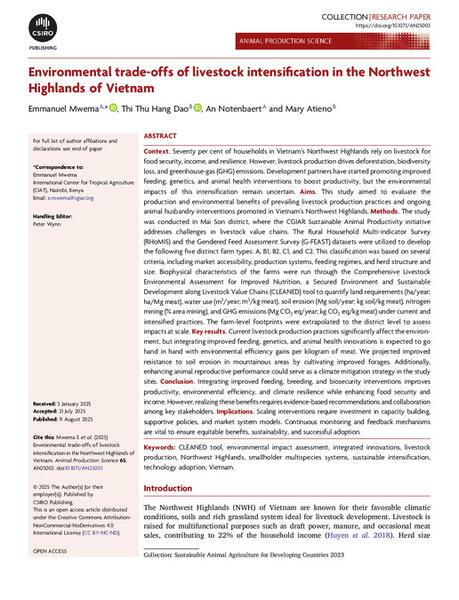
Context Seventy per cent of households in Vietnam’s Northwest Highlands rely on livestock for food security, income, and resilience. However, livestock production drives deforestation, biodiversity loss, and greenhouse-gas (GHG) emissions. Development partners have started promoting improved feeding, genetics, and animal health interventions to boost productivity, but the environmental impacts of this intensification remain uncertain. Aims This study aimed to evaluate the production and environmental benefits of prevailing livestock production practices and ongoing animal husbandry interventions promoted in Vietnam’s Northwest Highlands. Methods The study was conducted in Mai Son district, where the CGIAR Sustainable Animal Productivity initiative addresses challenges in livestock value chains. The Rural Household Multi-indicator Survey (RHoMIS) and the Gendered Feed Assessment Survey (G-FEAST) datasets were utilized to develop the following five distinct farm types: A, B1, B2, C1, and C2. This classification was based on several criteria, including market accessibility, production systems, feeding regimes, and herd structure and size. Biophysical characteristics of the farms were run through the Comprehensive Livestock Environmental Assessment for Improved Nutrition, a Secured Environment and Sustainable Development along Livestock Value Chains (CLEANED) tool to quantify land requirements (ha/year; ha/Mg meat), water use (m3/year; m3/kg meat), soil erosion (Mg soil/year; kg soil/kg meat), nitrogen mining (% area mining), and GHG emissions (Mg CO2 eq/year; kg CO2 eq/kg meat) under current and intensified practices. The farm-level footprints were extrapolated to the district level to assess impacts at scale. Key results Current livestock production practices significantly affect the environment, but integrating improved feeding, genetics, and animal health innovations is expected to go hand in hand with environmental efficiency gains per kilogram of meat. We projected improved resistance to soil erosion in mountainous areas by cultivating improved forages. Additionally, enhancing animal reproductive performance could serve as a climate mitigation strategy in the study sites. Conclusion Integrating improved feeding, breeding, and biosecurity interventions improves productivity, environmental efficiency, and climate resilience while enhancing food security and income. However, realizing these benefits requires evidence-based recommendations and collaboration among key stakeholders. Implications Scaling interventions require investment in capacity building, supportive policies, and market system models. Continuous monitoring and feedback mechanisms are vital to ensure equitable benefits, sustainability, and successful adoption.

